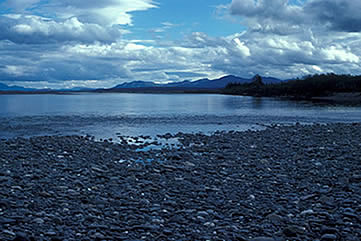
Courtesy of the United States Fish & Wildlife Service (SL-02902)
Noatak National Preserve is in the land north of the Arctic Circle. Here, on more than 6 million acres, is America’s largest protected mountain-ringed river basin. From its headwaters in Gates of the Arctic National Preserve through Noatak National Preserve, the Noatak River winds through spaces largely untouched by human presence. This river and valley reward travelers who make the journey northward to visit the park with opportunities to explore an Arctic landscape. The parkland and river are wild, remote but not forgotten spaces. In Noatak National Preserve and other units of the National Park System in Alaska, a number of native peoples continue traditional activities.
The sustainable use of natural resources is a key part of native culture. In the northern climate of Alaska, resources are not always plentiful. Subsistence, as a way of life, developed out of the need to survive scarcity. The first European exploration of Alaska in the 1740s introduced new technology and lifestyles to native Alaskans. The number of people in Alaska also began to grow. Competition for resources brought challenges to native traditions. Today, spaces like Noatak provide native populations with the opportunity to continue both the culture and traditions of subsistence hunting and gathering. This lifestyle takes no more than is necessary and has as little impact as possible on the environment.
Noatak National Preserve is an important space for visitors wishing to learn more about Alaska native culture. Within the park, visitors in the fall months may see the traditional seasonal hunt for caribou, a vital source of food later in the winter. In addition to caribou, sheep, moose, bears, and wolves are some of the larger animals in the park. Visitors may also encounter people fishing or picking berries. The relative isolation of the park permits visitors to experience an almost unchanged landscape that continues to support people, plants, and animals just as it has for more than 10,000 years since humans crossed into present-day North America via the Bering Land Bridge.
Visitors may explore the wilderness and wildlife of Noatak by hiking or camping in the park. Floating down the Noatak River is also a good way to see the spectacular, diverse Arctic landscape. To preserve this landscape for the future, there are no developed areas within the park. There are no marked trails, developed campsites, roads or exhibits within the park. Transportation to and from locations within the park is usually by plane. Within the park, hiking, fishing,
hunting, photography, camping, and rafting are popular activities. The park maintains a list of licensed river guides.
Visitors may learn more about the people and land of Alaska through exhibits at the Northwest Arctic Heritage Center in Kotzebue, Alaska, which is about 15 miles southwest of the southern boundary of the park. The center, which opened in 2010, presents programs on the cultures of Northwest Alaska, as well as the natural history of the region. The headquarters for Noatak National Preserve is also located in Kotzebue.
Noatak National Preserve, a unit of the National Park System, is located in AK. Access to the park is generally by air taxi, but also seasonally by snow machine, boat, or on foot. Planes may be chartered in Kotzebue or Bettles. Noatak National Preserve is always open. The headquarters in Kotzebue, AK is open 8:00am to 5:00pm during the week. The Northwest Arctic Heritage Center, also located in Kotzebue, provides information and exhibits highlighting three other parks in addition to Noatak. Kotzebue is served by regular air connections with Anchorage. The park is also accessible from Bettles, which is serviced by air from Fairbanks. For more information, visit the National Park Service Noatak National Preserve website or call 907-442-3890.
The park has been designated a UNESCO Biosphere Reserve and the Noatak River a Wild and Scenic River.
Last updated: June 10, 2024
